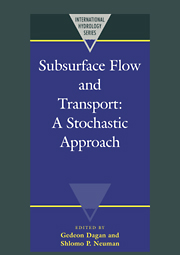Book contents
- Frontmatter
- Contents
- List of contributors
- Preface
- Acknowledgments
- I INTRODUCTION
- II SUBSURFACE CHARACTERIZATION AND PARAMETER ESTIMATION
- 1 Characterization of geological heterogeneity
- 2 Application of geostatistics in subsurface hydrology
- 3 Formulations and computational issues of the inversion of random fields
- III FLOW MODELING AND AQUIFER MANAGEMENT
- IV TRANSPORT IN HETEROGENEOUS AQUIFERS
- V FRACTURED ROCKS AND UNSATURATED SOILS
- VI A VIEW TO THE FUTURE
3 - Formulations and computational issues of the inversion of random fields
Published online by Cambridge University Press: 04 December 2009
- Frontmatter
- Contents
- List of contributors
- Preface
- Acknowledgments
- I INTRODUCTION
- II SUBSURFACE CHARACTERIZATION AND PARAMETER ESTIMATION
- 1 Characterization of geological heterogeneity
- 2 Application of geostatistics in subsurface hydrology
- 3 Formulations and computational issues of the inversion of random fields
- III FLOW MODELING AND AQUIFER MANAGEMENT
- IV TRANSPORT IN HETEROGENEOUS AQUIFERS
- V FRACTURED ROCKS AND UNSATURATED SOILS
- VI A VIEW TO THE FUTURE
Summary
ABSTRACT Three issues related to the inversion of random fields in groundwater flow problems are reviewed: problem formulation, computational methods and application methodology. Regarding the first, we show that most current methods can be viewed as particular cases of minimum variance estimation. While theory suggests that non-linear methods should lead to more accurate estimation and more realistic evaluation of uncertainty, differences obtained in intercomparison exercises appear to be much less significant than expected. This can be partly attributed to the fact that differences are more significant in the case of large variances, in the presence of sink/source terms, for large head data density and for small head measurement errors. Regarding computational aspects we present an improved version of the adjoint state method which should reduce significantly the computational burden of transient geostatistical inversion problems. Finally, application methodology is illustrated with a case comprising abundant steady-state head data and drawdowns from three pumping tests observed at a large set of points.
INTRODUCTION
Background
The groundwater flow inverse problem consists of estimating groundwater flow parameters on the basis of head measurements and, possibly, prior independent data about the parameters themselves. Aquifer modelers soon became interested in this problem after noticing that entering measured parameters directly into flow models led to poor results. That is, heads computed with such models did not agree with actual head measurements. Such behavior can be attributed to many factors. Spatial variability of these parameters, notably transmissivity and hydraulic conductivity, can be large and cannot be properly characterized by a few isolated measurements.
- Type
- Chapter
- Information
- Subsurface Flow and TransportA Stochastic Approach, pp. 62 - 80Publisher: Cambridge University PressPrint publication year: 1997
- 6
- Cited by



